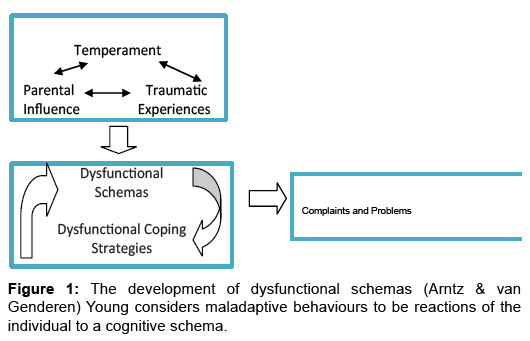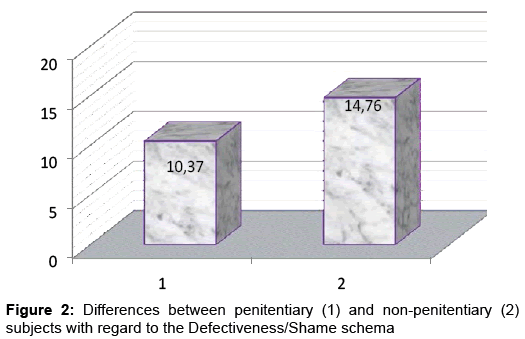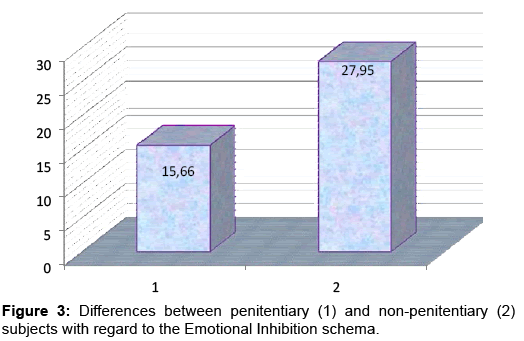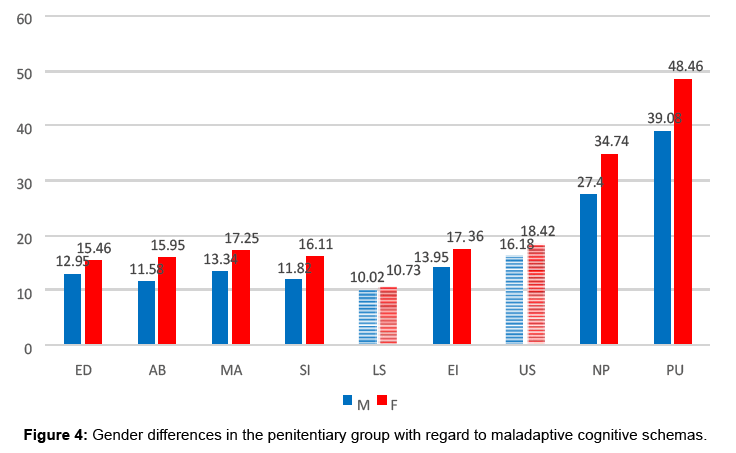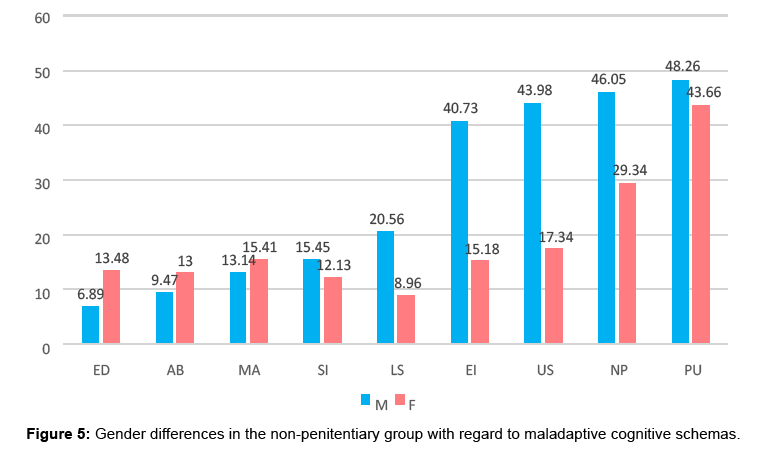Research Article, Int J Ment Health Psychiatry Vol: 3 Issue: 1
Assessing Maladaptive Cognitive Schemas as Predictors of Murder
Delcea Cristian1*, Enache Alexandra1 and Stanciu Camelia2
1Victor Babes University of Medicine and Pharmacy, Timisoara 300041, Romania
2“DimitrieCantemir” University of Tirgu-Mures, Romania
*Corresponding Author : Cristian Delcea, PhD
Victor Babes University of Medicine and Pharmacy, Timisoara 300041, Romania
Tel: 0742885979
E-mail: cristian.delcea.cj@gmail.com
Received: April 26, 2017 Accepted: May 09, 2017 Published: May 14, 2017
Citation: Delcea C, Enache A, Stanciu C (2017) Assessing Maladaptive Cognitive Schemas as Predictors of Murder. Int J Ment Health Psychiatry 3:1. doi: 10.4172/2471-4372.1000142
Abstract
The study aims to identify the existing differences between the maladaptive cognitive schemas of inmates and individuals outside the correction system, as well as possible gender differences. The theoretical foundation of the study started from the main theories in the specialised literature regarding early maladaptive cognitive schemas. The research involved a number of 492 adult subjects, split into two groups (incarcerated and non-incarcerated).
Keywords: Schema theory; Maladaptive cognitive schemas; Prison environment
Introduction
The theoretical foundations of the research
As shown in previous works, associating the theory of limited rationality and the theory of maladaptive cognitive schemas can provide a differential explanation for the decision making process of criminals [1]. In the field of cognitive research, the concept of schema refers to patterns that help the individual explain a situation or an experience, mediate perception and guide responses. The schema is an abstract representation of the distinctive characteristics of an event, a plan containing the most important elements [2] or a sketch – as it occurs as a description in Young’s opinion [3]. The features of early maladaptive cognitive schemas consist of the fact that they represent a generalised pattern built from memories, emotions, cognitions and bodily sensations, developed in childhood/adolescence and refined throughout the individual’s existence, referring to one’s own person and to relationships with others and dysfunctional for the individual to a significant extent [3]. Other authors consider schemas to be the fundamental beliefs of individuals used in order to form a vision regarding one’s self, the world and the future [4]. The mechanism by which maladaptive schemas are built and developed (based on research involving individuals with borderline disorder) is presented by Arntz and van Genderen [5] (Figure 1).
According to Wortley [6], schemas are based on information stored in the individual’s memory related to a specific field. All knowledge of the world, which the individual has accumulated, are organised into schemas.
Michel van Vreeswijk and Broersen [7] identified 18 early maladaptive schemas, grouped into 5 psychopathological styles in the case of individuals with antisocial personality disorder.
A study carried out by Enache, A. and col. in Romania on a sample of 271 incarcerated women demonstrated the existence of a statistically significant correlation between neuroticism and low gravity offences. This personality trait has been identified as a structural aspect of female criminals, but it can also be seen as a reaction to lack of freedom [8].
Current research shows that in the history of these individuals can be found juvenile delinquency, a lack of educational and/or social conditions; individuals are characterized by acceptance of risk situations, high levels of impulsivity and low self-control [9].
Our recent research on subjects who had committed murder has shown that Abandonment/Instability, Emotional deprivation and Social isolation are frequent maladaptive cognitive schemas [10].
Participants
The total study sample consisted of 492 (N=492) adult participants, 50% of whom were female and 50% male. The average age of the sample was 34.14 (SD=10.66, Min 18, Max 68), and the average education level was 12 grades/high school (SD=2.01).
The participants are classified into two major groups: The penitentiary group (P) consists of 246 (N=246) participants, equally grouped according to gender, while the control group (NP) consists of 246 (N=246) participants, sub-grouped according to gender.
The penitentiary group (P)
The penitentiary sample (P) consists of 246 (N=246) participants, of which 50% female and 50% male. Their average age is 37.32 (SD=9.93, Min 18, Max 68), and the average education level is 11 grades (SD=1.82) (Table 1).
| N | Min. | Max. | M. | SD. | |
|---|---|---|---|---|---|
| Age | 246 | 18.00 | 68.00 | 37.3252 | 9.93776 |
| Education | 246 | 8.00 | 16.00 | 10.9309 | 1.82256 |
Table 1: The composition of the penitentiary sample regarding age and education level.
The control group (non-penitentiary NP)
The control sample (NP) consists of 492 (N=492) adult participants, of which 50% female and 50% male. Their average age is 30.95 (SD=10.42, Min 18, Max 68), and the average education level is 11.63 grades (SD=2.13) (Table 2).
| N | Min. | Max. | M | SD | |
|---|---|---|---|---|---|
| Age | 246 | 18.00 | 68.00 | 30.9553 | 10.42456 |
| Education | 246 | 8.00 | 16.00 | 11.6301 | 2.13172 |
Table 2: The composition of the non-penitentiary sample regarding age and education level.
Instruments
Young Cognitive Schema Questionnaire in its short form (YSQ-S3).
Procedure
Data processing
Data collection was followed by introducing them in the database. The statistical data was processed using the SPSS software (Statistical Package for the Social Sciences) version 20.0. Besides descriptive statistics, groups were also compared using the t-test and ANCOVA. The significance level is set to p ≤ 0.05.
Results
Differences between the penitentiary (P) and nonpenitentiary (NP) groups with regard to maladaptive cognitive schemas
Preliminary results
In order to determine age differences between subject groups we performed the t-test, and preliminary results showed that there is a significant age difference (t=-6.93, p=.000) between the two groups (penitentiary and non-penitentiary), inmates being significantly older than the non-incarcerated group.
In order to determine educational differences between groups we performed the t-test, and preliminary results showed that there is a significant educational difference (t=.35, p=.00) between the two groups (penitentiary and non-penitentiary). From the point of view of education, non-incarcerated subjects had a higher educational level than inmates did.
To compare the two groups, we used the ANCOVA statistical test, where age and educational level were introduced as covariants, so that the difference would not bias the results.
Differences between the penitentiary (P) and nonpenitentiary (NP) groups with regard to maladaptive cognitive schemas (separation and rejection and hypervigilance and inhibition)
Maladaptive cognitive schemas are grouped in two fields: separation and rejection, containing 5 schemas, and hypervigilance and inhibition, containing 4 schemas.
The first field is represented by separation and rejection and consists of the expectancy that security, safety, care, empathy and acceptance needs will not be satisfied. Out of this first field, we chose to analyse the Defectiveness/shame (LS).
ANCOVA analyses show that there is a significant difference in LS (Defectiveness/shame), after the age effect is controlled, F (1, 492)=15.92, p=.000), and after the education effect is controlled, F (1, 492)=16.46, p=.000). Inmates (M=10,37, SD=5,43) present a significantly lower LS level compared to the control group, the nonincarcerated subjects (M=14,76, SD=22,04). Figure 2 graphically represents these results.
The next field is given by hypervigilance and inhibition – feelings, impulses, spontaneous choices are prevented from being expressed, and the individual does not reserve the right to be happy. We selected for analysis Emotional Inhibition (IE).
ANCOVA analyses show a significant difference in terms of EI (Emotional inhibition), after controlling the age effect F (1, 492)=128.614, p=.000), and after controlling the educational effect, F (1, 492)=87.319, p=.000). Inmates (M=15,66, SD=5,78) present a significantly lower level of emotional inhibition compared to the control, non-incarcerated group (M=27,95, SD=18,27). Figure 3 graphically illustrates these results.
Differences in maladaptive cognitive schemas depending on gender in penitentiary and non-penitentiary subjects
Gender differences between maladaptive cognitive schemas in the penitentiary group: Preliminary analyses showed no significant age (t=.988, p=.32) or educational (t=.03, p=.972) difference between the two sexes in the penitentiary group, which is why the t-test (t – test for independent samples) was used in order to compare the groups. The level of significance is set at p ≤ 0.05.
As the table below shows, in the case of Separation and rejection maladaptive schemas, significant differences were found in between men and women in all four schemas apart from Defectiveness/shame (LS): Emotional deprivation (ED), Abandonment/Instability (AB), Mistrust/Abuse (MA) and Social isolation/ Estrangement (SI).
In the field of Hypervigilance and inhibition, significant differences were found in between men and women in all schemas apart from Unrealistic standards/Hypercriticism (US): Emotional Inhibition (EI), Negativism/Passivity (NP), Punishment (PU).
Results in Table 3 shows that in the penitentiary group, women have a significantly higher level of maladaptive cognitive schemas than men in the case of ED (t=-2.727, p=.007); AB (t=-5.188, p=.000); MA (t=-4.963, p=.000); SI (t=-5.563, p=.000); EI (t=-4.826, p=.000); NP (t= -4.978, p= .000); PU (t=-5.438, p=.000).
| Sex | N | M | SD | t | df | p | ||
|---|---|---|---|---|---|---|---|---|
| Separation and rejection | ED | M | 123 | 12.9593 | 7.24331 | -2.727 | 243.965 | .007 |
| F | 123 | 15.4634 | 7.15667 | |||||
| AB | M | 123 | 11.5854 | 6.92457 | -5.188 | 2 | .000 | |
| F | 123 | 15.9512 | 6.25661 | |||||
| MA | M | 123 | 13.3496 | 6.78473 | -4.963 | 233.627 | .000 | |
| F | 123 | 17.2520 | 5.47811 | |||||
| SI | M | 123 | 11.8293 | 6.49427 | -5.563 | 244 | .000 | |
| F | 123 | 16.1138 | 5.54742 | |||||
| LS | M | 123 | 10.0244 | 5.91118 | -1.021 | 244 | .308 | |
| F | 123 | 10.7317 | 4.90245 | |||||
| Hypervigilance and inhibition | EI | M | 123 | 13.9593 | 6.69279 | -4.826 | 244 | .000 |
| F | 123 | 17.3659 | 4.06155 | |||||
| US | M | 123 | 16.1870 | 20.65539 | -1.176 | 132.118 | .242 | |
| F | 123 | 18.4228 | 4.20968 | |||||
| NP | M | 123 | 27.4065 | 12.34400 | -4.978 | 239.368 | .000 | |
| F | 123 | 34.7480 | 10.73114 | |||||
| PU | M | 123 | 39.0894 | 15.72093 | -5.438 | 244 | .000 | |
| F | 123 | 48.4634 | 10.87657 | |||||
Table 3: Differences between men and women in the penitentiary group with regard to maladaptive cognitive schemas (the results of the t-test for independent samples).
The figure below graphically illustrates the results (Figure 4).
Gender differences between maladaptive cognitive schemas in the non-penitentiary group: Preliminary analyses showed that there is no significant difference in education between men and women, but there is a significant age difference (t=3.05, p=.003) between the two groups, male participants being significantly older than the female ones.
In order to test the hypotheses we used covariation analysis (ANCOVA). The test is used in order to examine differences between the average values of the dependant variable under the effect of controlled independent variables, after the effect of uncontrolled independent variables (age) is isolated.
Our ANCOVA analyses showed significant differences between men and women in the non-penitentiary group, in all maladaptive cognitive schemas in the field of Separation and rejection, after the effect of age was isolated: ED (Emotional Deprivation) F (1,243)=54.648, p=.000); AB (Abandonment, Instability) F (1,243)=17.035, p=.000); MA (Mistrust, Abuse) F (1,243)=7.289, p=.007); SI (Social Isolation, Estrangement) F (1,243)=15.287, p=.000) and LS (Defectiveness, Shame) F (1, 243)=16.161, p=.000).
Our ANCOVA analyses showed significant differences between men and women in the non-penitentiary group, in all maladaptive cognitive schemas in the field of Hypervigilance and Inhibition, after the effect of age was isolated: EI (Emotional Inhibition) F (1, 243)=216.754, p=.000); US (Hypercriticism), F (1, 243)=217.910, p=.000); NP (Negativism) F (1, 243)=97.395, p=.000); PU (Punishment) F (1, 243)=11.800, p=.001).
The figure below graphically illustrates the results (Figure 5).
As the figure above shows, women have a significantly higher level of Emotional Deprivation (men (M=6.8943, SD=5.73144); women (M=13.4878, SD=7.21152), Abandonment/Instability (men (M=9.4715, SD=5.67180); women (M=,13.0081 SD=6.64991) and Mistrust/Abuse (men (M=13.1463, SD=6.17860); women (M=15.4146, SD=5.56913), but in all other cognitive schemas, men have a significantly higher level, such as in Social Isolation/ Estrangement (men (M=15.4553, SD=7.05976); women (M=12.1301, SD=6.48701), Defectiveness/Shame (men (M=20.5610, SD=29.78699); women (M=8.9675, SD=4.57709), Emotional Inhibition (men (M=40.7317, SD=17.89820); women (M=15.1870, SD=4.59570), Hypercriticism (men (M=43.9837, SD=18.70653); women (M=17.3415, SD=4.38670), Negativism (men (M=46.0569, SD=14.45247); women (M=29.3415, SD=10.60608), Punishment (men (M=48.2683, SD=8.57663); women (M=43.6667, SD=11.62083).
Conclusion
In conclusion, this study demonstrates the existence and importance of maladaptive cognitive schemas as predictors of human behaviour that violates social and moral norms imposed by society. The results obtained clearly indicate that prisoners have a significantly lower scores than individuals outside the penitentiary in terms of Emotional Inhibition and Shame. Based on the results, we aim to outline intervention programs based on maladaptive cognitive schemas.
References
- Delcea C, Stanciu C (2016) Approaches of the decision making involved in the act of homicide. The Proceedings of the International Conference Globalization, Intercultural Dialogue and National Identity (GIDNI 3), Arhipelag XXI press, Tîrgu Mureș, Romania.
- Rafaeli E, Bernstein DP, Young J (2011) Schema Therapy. Routledge. Taylor & Francis. Abingdon, United Kingdom.
- Young JE, Klosko JS, Weishaar ME (2015) Terapia centrată pe scheme cognitive.Manualul practicianului.
- Sperry L (2007) Cognitive behavior Therapy of DSM-IV-TR Personality Disorders. Second Edition. Routledge. Taylor & Francis. Abingdon,United Kingdom.
- Arntz A, van Genderen H (2009) Schema Therapy for Borderline Personality Disorder, Wiley-Blackwell, A John Wiley&Sons.Hoboken, New Jersey, United States.
- Leclerc B, Wortley R (2014) Cognition and Crime. Offender Decision Making and Script Analyses Routledge, Taylor & Francis Group.Abingdon,United Kingdom.
- Vreeswijk van M, Broersen J, Nadort M (2012) Handbook of Schema Therapy: Theory, Research and Practice, Wiley-Blackwell, John Wiley & Sons, Hoboken, New Jersey, USA.
- Enache A & col (2009) Factorii asociaÅ£i comportamentului antisocial. Studiu efectuat asupra unui grup de femei infractoare din România, în Pasca, V, Infracționalitatea feminină, Ed. Universitatea de Vest, Timişoara, Romania.
- MËller-Fabian A, Delcea C (2017) Juvenile Delinquent’s Decision Making Capacity in Risk Situations: A Multifactorial Approach. Int J Ment Health Psychiatry 3.
- Delcea C, Enache A (2017) Individual Differences in Personality and Reasoning Traits between Individuals Accused of Murder and those who have not Committed Murder. Int J Ment Health Psychiatry 3.
 Spanish
Spanish  Chinese
Chinese  Russian
Russian  German
German  French
French  Japanese
Japanese  Portuguese
Portuguese  Hindi
Hindi 